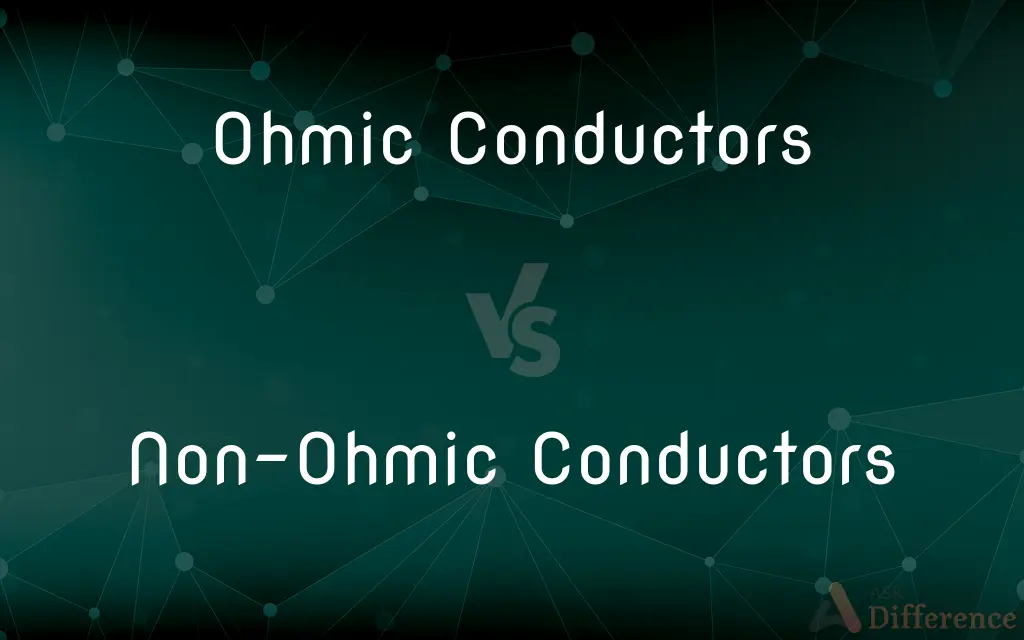Ohmic Conductors vs. Non-Ohmic Conductors — What's the Difference?
By Tayyaba Rehman — Published on January 22, 2024
Ohmic conductors obey Ohm's Law, showing a linear relationship between voltage and current, whereas non-ohmic conductors do not, exhibiting a nonlinear voltage-current relationship.

Difference Between Ohmic Conductors and Non-Ohmic Conductors
Table of Contents
ADVERTISEMENT
Key Differences
Ohmic conductors, such as copper, have a constant resistance and follow Ohm's Law, meaning their voltage and current are directly proportional. Non-ohmic conductors, like diodes, have varying resistance, and their voltage-current relationship is not linear.
In ohmic conductors, the resistance remains consistent across different voltages. In contrast, non-ohmic conductors display changing resistance with varying voltage levels.
Examples of ohmic conductors include most metals and resistors designed to have a fixed resistance. Non-ohmic conductors are often semiconductor devices like transistors and thyristors, where resistance changes with voltage.
The linear graph of voltage vs. current for ohmic conductors is a straight line, whereas for non-ohmic conductors, the graph is curved, indicating the non-linear relationship.
Ohmic conductors are typically used in situations where a stable and predictable current is required, while non-ohmic conductors are useful in electronic circuits where varying resistance is needed for functions like rectification or amplification.
ADVERTISEMENT
Comparison Chart
Voltage-Current Relationship
Linear (direct proportionality)
Nonlinear
Resistance Behavior
Constant across different voltages
Varies with voltage
Examples
Metals like copper, fixed resistors
Semiconductor devices like diodes, transistors
Graph Shape
Straight line in a voltage-current graph
Curved line in a voltage-current graph
Typical Use
Stable, predictable current applications
Electronic circuits with varying resistance
Compare with Definitions
Ohmic Conductors
Ohmic conductors exhibit a linear voltage-current relationship.
The graph for the ohmic conductor is a straight line, showing linearity.
Non-Ohmic Conductors
Non-ohmic conductors are used in complex electronic applications.
Transistors, as non-ohmic conductors, are crucial in amplification and switching tasks.
Ohmic Conductors
Ohmic conductors are typically made of materials like metals.
Silver, an ohmic conductor, is used for its low resistance in electronic components.
Non-Ohmic Conductors
Non-ohmic conductors include semiconductor devices.
Diodes, a type of non-ohmic conductor, are essential in rectifying circuits.
Ohmic Conductors
Ohmic conductors are used where steady current flow is needed.
Ohmic conductors are ideal for basic electrical circuits requiring a stable current.
Non-Ohmic Conductors
Non-ohmic conductors are characterized by their changing resistance.
The non-ohmic conductor's resistance varied, making it useful for controlling current in the circuit.
Ohmic Conductors
Ohmic conductors have a constant resistance and follow Ohm's Law.
Copper wires in household circuits are ohmic conductors, offering consistent resistance.
Non-Ohmic Conductors
Non-ohmic conductors do not have a constant resistance.
The resistance of the non-ohmic conductor changed as the voltage increased.
Ohmic Conductors
Ohmic conductors maintain proportionality between voltage and current.
In the ohmic conductor, doubling the voltage doubled the current.
Non-Ohmic Conductors
Non-ohmic conductors show a nonlinear relationship between voltage and current.
In the non-ohmic conductor, the current did not increase proportionally with voltage.
Common Curiosities
What are examples of non-ohmic conductors?
Examples include semiconductor devices like diodes and transistors.
What defines an ohmic conductor?
An ohmic conductor is defined by its constant resistance and linear voltage-current relationship according to Ohm's Law.
Why are non-ohmic conductors nonlinear?
Their resistance varies with voltage, leading to a nonlinear voltage-current relationship.
Are all metals ohmic conductors?
Most metals are ohmic conductors, but some can exhibit non-ohmic behavior under certain conditions.
What role do non-ohmic conductors play in electronics?
They are used in applications requiring variable resistance, such as in rectifying and amplifying circuits.
Can the resistance of an ohmic conductor change?
The resistance of an ohmic conductor remains constant under standard conditions.
How is the graph of an ohmic conductor characterized?
The graph of an ohmic conductor is a straight line in a voltage-current plot.
Is copper wire an ohmic or non-ohmic conductor?
Copper wire is an example of an ohmic conductor.
Can temperature affect the behavior of ohmic conductors?
Yes, extreme temperatures can affect resistance, but under normal conditions, ohmic conductors maintain constant resistance.
Are non-ohmic conductors used in household appliances?
Yes, they are used in various household electronics for specific functions like controlling current flow.
Can ohmic conductors be used in computer chips?
Computer chips typically require non-ohmic conductors like semiconductors for complex tasks.
Do non-ohmic conductors obey Ohm's Law?
No, non-ohmic conductors do not follow Ohm's Law due to their variable resistance.
Are ohmic conductors energy efficient?
Yes, due to their constant resistance, ohmic conductors are generally energy efficient under normal operating conditions.
Why do ohmic conductors have a constant resistance?
Ohmic conductors have a uniform structure and material composition, leading to constant resistance.
How does temperature affect ohmic and non-ohmic conductors?
In ohmic conductors, resistance slightly changes with temperature, while in non-ohmic conductors, temperature can significantly impact their voltage-current relationship.
Can a material be both ohmic and non-ohmic?
Some materials can exhibit both behaviors under different conditions, but they are typically classified based on their behavior in standard conditions.
Are there safety concerns with using non-ohmic conductors?
Proper design and usage are crucial as non-ohmic conductors can behave unpredictably under certain conditions, posing potential safety risks.
What is a practical application of ohmic conductors?
They are used in basic electrical wiring and circuits where steady current is required.
Is resistance always the same in an ohmic conductor?
While resistance in an ohmic conductor is generally constant, it can vary slightly with changes in temperature or material degradation.
How does the cost of ohmic and non-ohmic conductors compare?
Generally, ohmic conductors like copper and aluminum are less expensive than many non-ohmic conductors used in specialized electronic components.
How does the environmental impact of ohmic and non-ohmic conductors compare?
The environmental impact varies widely based on the material and application, but in general, the production and disposal of electronic components with non-ohmic conductors can be more environmentally impactful.
How does voltage affect a non-ohmic conductor?
In non-ohmic conductors, changes in voltage lead to disproportionate changes in current.
Can you give an example of a non-ohmic conductor?
A diode is a common example of a non-ohmic conductor.
Why are ohmic conductors preferred in household wiring?
Ohmic conductors are preferred in household wiring due to their predictable and stable resistance, ensuring safe and consistent electrical performance.
What is the significance of a nonlinear voltage-current relationship in non-ohmic conductors?
It allows non-ohmic conductors to be used in applications like voltage regulation and signal modulation.
Are semiconductors ohmic or non-ohmic?
Semiconductors are generally non-ohmic conductors, as their resistance changes with voltage.
Do non-ohmic conductors have a place in everyday electrical appliances?
Yes, non-ohmic conductors are used in many everyday appliances for functions like dimming lights, regulating temperatures, and processing signals.
Share Your Discovery

Previous Comparison
Cache vs. Memory
Next Comparison
Political Science vs. SociologyAuthor Spotlight
Written by
Tayyaba RehmanTayyaba Rehman is a distinguished writer, currently serving as a primary contributor to askdifference.com. As a researcher in semantics and etymology, Tayyaba's passion for the complexity of languages and their distinctions has found a perfect home on the platform. Tayyaba delves into the intricacies of language, distinguishing between commonly confused words and phrases, thereby providing clarity for readers worldwide.
















































